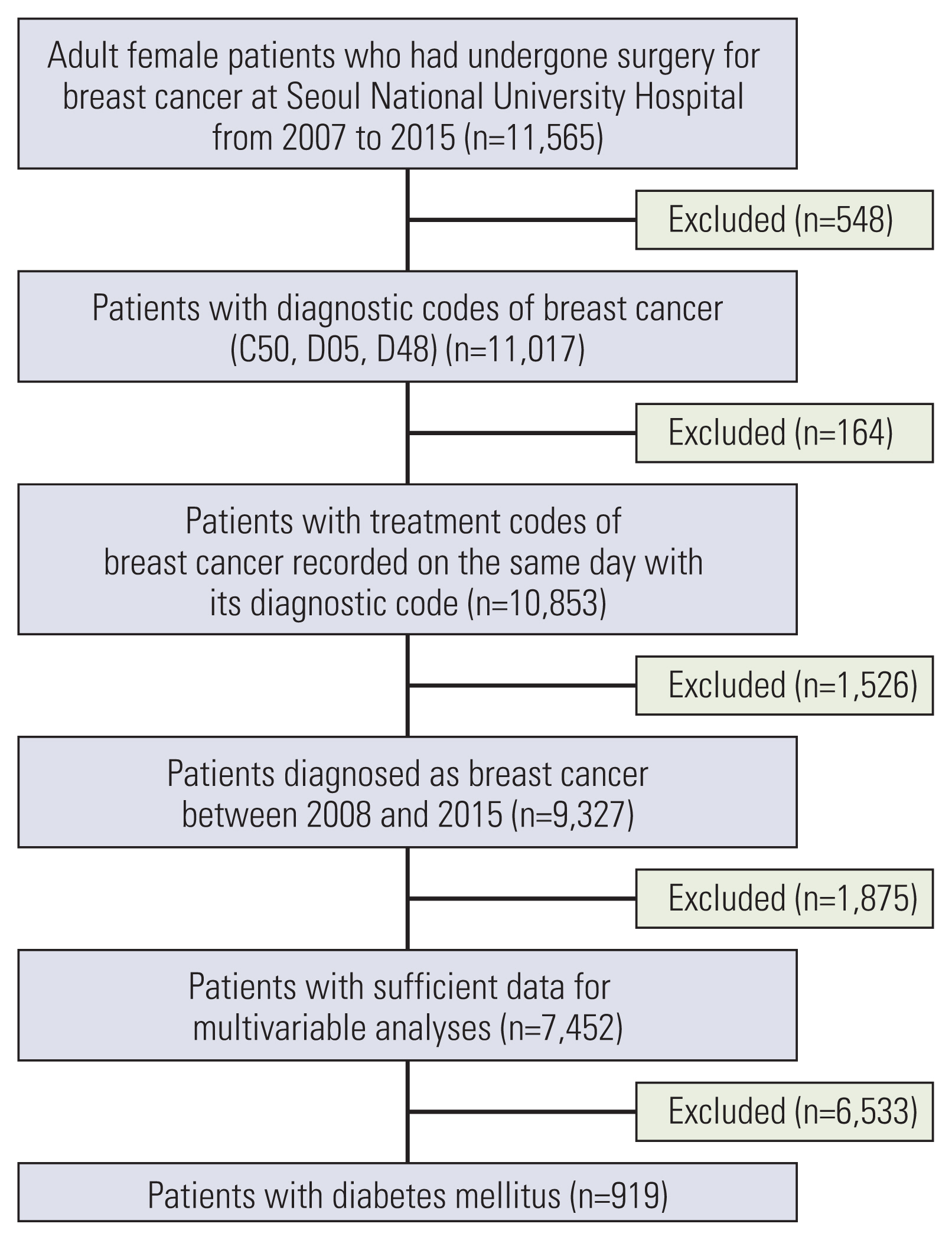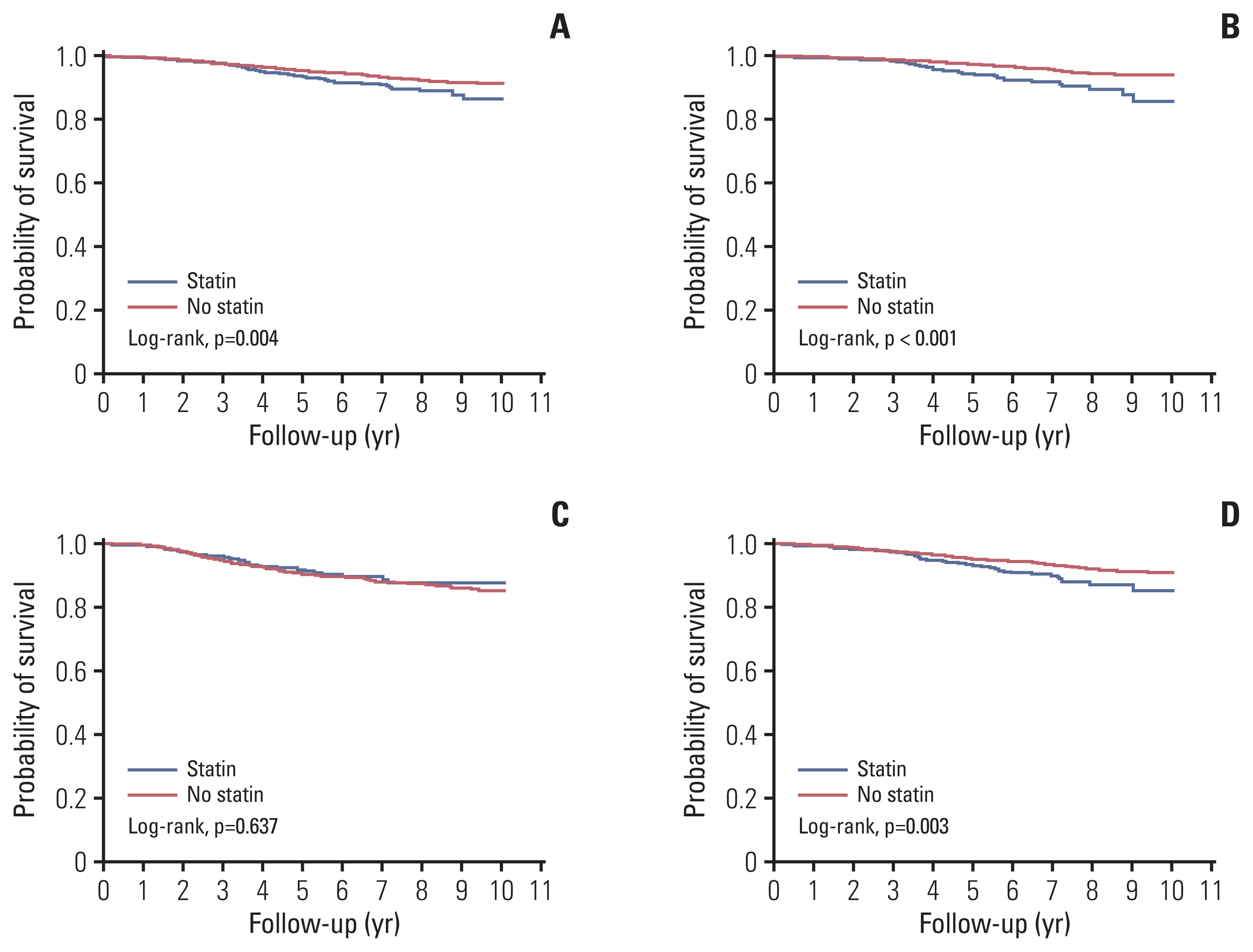Cancer Res Treat.
2021 Jan;53(1):65-76. 10.4143/crt.2020.430.
Association of Insulin, Metformin, and Statin with Mortality in Breast Cancer Patients
- Affiliations
-
- 1Department of Internal Medicine, The Catholic University of Korea Incheon St. Mary’s Hospital, Incheon, Korea
- 2Department of Internal Medicine, Seoul National University Hospital, Seoul, Korea
- 3Medical Research Collaborating Center, Seoul National University Hospital, Seoul, Korea
- 4Cancer Research Institute, Seoul National University, Seoul, Korea
- 5Department of Surgery, Seoul National University Hospital, Seoul, Korea
- KMID: 2510648
- DOI: http://doi.org/10.4143/crt.2020.430
Abstract
- Purpose
This study investigated the association of insulin, metformin, and statin use with survival and whether the association was modified by the hormone receptor status of the tumor in patients with breast cancer.
Materials and Methods
We studied 7,452 patients who had undergone surgery for breast cancer at Seoul National University Hospital from 2008 to 2015 using the nationwide claims database. Exposure was defined as a recorded prescription of each drug within 12 months before the diagnosis of breast cancer.
Results
Patients with prior insulin or statin use were more likely to be older than 50 years at diagnosis and had a higher comorbidity index than those without it (p < 0.01 for both). The hazard ratio (HR) for death with insulin use was 5.7 (p < 0.01), and the effect was attenuated with both insulin and metformin exposure with an HR of 1.2 (p=0.60). In the subgroup analyses, a heightened risk of death with insulin was further prominent with an HR of 17.9 (p < 0.01) and was offset by co-administration of metformin with an HR of 1.3 (p=0.67) in patients with estrogen receptor (ER)–negative breast cancer. Statin use was associated with increased overall mortality only in patients with ER-positive breast cancer with HR for death of 1.5 (p=0.05).
Conclusion
Insulin or statin use before the diagnosis of breast cancer was associated with an increase in all-cause mortality. Subsequent analyses suggested that metformin or statin use may have been protective in patients with ER-negative disease, which warrants further studies.
Keyword
Figure
Reference
-
References
1. Lee YH, Yoon SJ, Kim A, Seo H, Ko S. Health performance and challenges in Korea: a review of the global burden of disease study 2013. J Korean Med Sci. 2016; 31(Suppl 2):S114–20.
Article2. GBD 2017 Causes of Death Collaborators. Global, regional, and national age-sex-specific mortality for 282 causes of death in 195 countries and territories, 1980–2017: a systematic analysis for the Global Burden of Disease Study 2017. Lancet. 2018; 392:1736–88.3. Mehta LS, Watson KE, Barac A, Beckie TM, Bittner V, Cruz-Flores S, et al. Cardiovascular disease and breast cancer: where these entities intersect: a scientific statement from the American Heart Association. Circulation. 2018; 137:e30–66.
Article4. Tang GH, Satkunam M, Pond GR, Steinberg GR, Blandino G, Schunemann HJ, et al. Association of metformin with breast cancer incidence and mortality in patients with type II diabetes: a GRADE-assessed systematic review and meta-analysis. Cancer Epidemiol Biomarkers Prev. 2018; 27:627–35.
Article5. Beckwitt CH, Brufsky A, Oltvai ZN, Wells A. Statin drugs to reduce breast cancer recurrence and mortality. Breast Cancer Res. 2018; 20:144.
Article6. Chen L, Chubak J, Boudreau DM, Barlow WE, Weiss NS, Li CI. Diabetes treatments and risks of adverse breast cancer outcomes among early-stage breast cancer patients: a SEER-medicare analysis. Cancer Res. 2017; 77:6033–41.
Article7. Borgquist S, Giobbie-Hurder A, Ahern TP, Garber JE, Colleoni M, Lang I, et al. Cholesterol, cholesterol-lowering medication use, and breast cancer outcome in the BIG 1–98 study. J Clin Oncol. 2017; 35:1179–88.
Article8. Sonnenblick A, Agbor-Tarh D, Bradbury I, Di Cosimo S, Azim HA Jr, Fumagalli D, et al. Impact of diabetes, insulin, and metformin use on the outcome of patients with human epidermal growth factor receptor 2-positive primary breast cancer: analysis from the ALTTO phase III randomized trial. J Clin Oncol. 2017; 35:1421–9.
Article9. Jackson JW, Garcia-Albeniz X. Studying the effects of nonindicated medications on cancer: etiologic versus action-focused analysis of epidemiologic data. Cancer Epidemiol Biomarkers Prev. 2018; 27:520–4.
Article10. Liu B, Yi Z, Guan X, Zeng YX, Ma F. The relationship between statins and breast cancer prognosis varies by statin type and exposure time: a meta-analysis. Breast Cancer Res Treat. 2017; 164:1–11.
Article11. Bhoo-Pathy N, Yip CH, Hartman M, Uiterwaal CS, Devi BC, Peeters PH, et al. Breast cancer research in Asia: adopt or adapt Western knowledge? Eur J Cancer. 2013; 49:703–9.
Article12. Kim DS. Introduction: health of the health care system in Korea. Soc Work Public Health. 2010; 25:127–41.
Article13. Kim JA, Yoon S, Kim LY, Kim DS. Towards actualizing the value potential of Korea Health Insurance Review and Assessment (HIRA) data as a resource for health research: strengths, limitations, applications, and strategies for optimal use of HIRA data. J Korean Med Sci. 2017; 32:718–28.
Article14. Charlson ME, Pompei P, Ales KL, MacKenzie CR. A new method of classifying prognostic comorbidity in longitudinal studies: development and validation. J Chronic Dis. 1987; 40:373–83.
Article15. Quan H, Sundararajan V, Halfon P, Fong A, Burnand B, Luthi JC, et al. Coding algorithms for defining comorbidities in ICD-9-CM and ICD-10 administrative data. Med Care. 2005; 43:1130–9.
Article16. Greene FL, Page DL, Fleming ID, Fritz AG, Balch CM, Haller DG, et al. AJCC cancer staging manual. 6th ed. New York: Springer;2002.17. Edge SB, Byrd DR, Compton CC, Fritz AG, Greene FL, Trotti A. AJCC cancer staging manual. 7th ed. New York: Springer;2010.18. Gernaat SAM, Ho PJ, Rijnberg N, Emaus MJ, Baak LM, Hartman M, et al. Risk of death from cardiovascular disease following breast cancer: a systematic review. Breast Cancer Res Treat. 2017; 164:537–55.
Article19. Abdel-Qadir H, Austin PC, Lee DS, Amir E, Tu JV, Thavendiranathan P, et al. A population-based study of cardiovascular mortality following early-stage breast cancer. JAMA Cardiol. 2017; 2:88–93.
Article20. Hershman DL, Till C, Shen S, Wright JD, Ramsey SD, Barlow WE, et al. Association of cardiovascular risk factors with cardiac events and survival outcomes among patients with breast cancer enrolled in SWOG clinical trials. J Clin Oncol. 2018; 36:2710–7.
Article21. American Diabetes Association. 8 Pharmacologic approaches to glycemic treatment: standards of medical care in diabetes-2018. Diabetes Care. 2018; 41(Suppl 1):S73–85.22. Chou R, Dana T, Blazina I, Daeges M, Jeanne TL. Statins for prevention of cardiovascular disease in adults: evidence report and systematic review for the US Preventive Services Task Force. JAMA. 2016; 316:2008–24.
Article23. Duggan C, Irwin ML, Xiao L, Henderson KD, Smith AW, Baumgartner RN, et al. Associations of insulin resistance and adiponectin with mortality in women with breast cancer. J Clin Oncol. 2011; 29:32–9.
Article24. Chappell J, Leitner JW, Solomon S, Golovchenko I, Goalstone ML, Draznin B. Effect of insulin on cell cycle progression in MCF-7 breast cancer cells. Direct and potentiating influence. J Biol Chem. 2001; 276:38023–8.25. Calle EE, Kaaks R. Overweight, obesity and cancer: epidemiological evidence and proposed mechanisms. Nat Rev Cancer. 2004; 4:579–91.
Article26. Dowling RJ, Zakikhani M, Fantus IG, Pollak M, Sonenberg N. Metformin inhibits mammalian target of rapamycin-dependent translation initiation in breast cancer cells. Cancer Res. 2007; 67:10804–12.
Article27. Goodwin PJ, Parulekar WR, Gelmon KA, Shepherd LE, Ligibel JA, Hershman DL, et al. Effect of metformin vs placebo on and metabolic factors in NCIC CTG MA.32. J Natl Cancer Inst. 2015; 107:djv006.
Article28. Liu B, Fan Z, Edgerton SM, Deng XS, Alimova IN, Lind SE, et al. Metformin induces unique biological and molecular responses in triple negative breast cancer cells. Cell Cycle. 2009; 8:2031–40.
Article29. Goard CA, Chan-Seng-Yue M, Mullen PJ, Quiroga AD, Wasylishen AR, Clendening JW, et al. Identifying molecular features that distinguish fluvastatin-sensitive breast tumor cells. Breast Cancer Res Treat. 2014; 143:301–12.
Article30. Campbell MJ, Esserman LJ, Zhou Y, Shoemaker M, Lobo M, Borman E, et al. Breast cancer growth prevention by statins. Cancer Res. 2006; 66:8707–14.
Article31. Goodwin PJ, Ennis M, Pritchard KI, Trudeau ME, Koo J, Taylor SK, et al. Insulin- and obesity-related variables in early-stage breast cancer: correlations and time course of prognostic associations. J Clin Oncol. 2012; 30:164–71.
Article
- Full Text Links
- Actions
-
Cited
- CITED
-
- Close
- Share
- Similar articles
-
- Association between Metformin Therapy and Breast Cancer Incidence and Mortality: Evidence from a Meta-Analysis
- Effects of Metformin on Breast Cancer Risk and Mortality in Type 2 Diabetes Mellitus: A Systematic Review and Meta-analysis
- Diabetes and Cancer: Is Diabetes Causally Related to Cancer?
- The Metformin Use and Gastric Cancer Risk
- Diabetes Medication Use in Association with Survival among Patients of Breast, Colorectal, Lung, or Gastric Cancer






